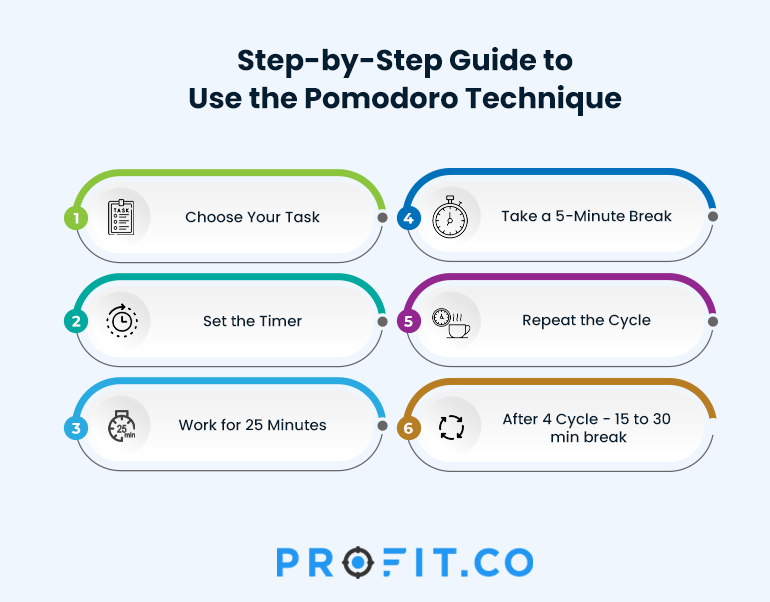Your to-do list is staring at you. You’re staring back. A silent standoff. You know what needs to get done, but instead of getting right to it, you freeze. Too many tasks. Too many distractions. Too many tabs open.Or you could start strong full speed ahead! only to be derailed by an email or a notification… then a quick scroll through Instagram… and suddenly, an hour has disappeared.
Sound all too familiar? You’re not alone. Focus is hard. In a world built for distraction, it takes real effort to stay on task.
But what if there was a simple way to work with your brain—not against it?
Sounds magical not really a simple common sense solution. Now, why didn’t I think of it?
Yes, it is the ridiculously simple Pomodoro Technique.
Set a timer for 25 minutes. Work on one thing. Take a short break. Repeat.
That’s it. No complicated systems. No fancy apps are required. It is just a proven method, first introduced by Francesco Cirillo in the late 1980s, that helps you get more done without the stress, the burnout, or the constant battle with your own attention span.
Because productivity shouldn’t be painful. It should be easy.

Francesco Cirillo (credits to Francesco Cirillo)
In this guide, we are breaking down everything you need to know about the Pomodoro Technique in-depth: how to use it, the benefits you can expect, and tips for overcoming the most common challenges. Our goal is to help you get the most out of this method so that you can see supercharged results in your life.
What Is the Pomodoro Technique, and Why Does It Work?
What is Pomodoro? This Italian word literally translates to “tomato,” and the method developed its name because it was inspired by a tomato timer.

The Pomodoro Technique is built on structured focus intervals that prevent burnout while keeping your brain engaged.
- Pick a task. Choose a single task to focus on.
- Set a timer for 25 minutes. Work without distractions.
- Take a 5-minute break. Step away to recharge.
- Repeat four cycles. Then, take a longer 15–30 minute break.
Why does it work?
This method stands out from other traditional time management strategies because it prioritizes focused work intervals and intentional breaks, which helps to improve concentration. Your brain stays engaged without exhaustion because it expects a break. You eliminate multitasking, focusing on one task at a time. Shorter work sessions prevent overwhelm and procrastination. This isn’t just a theory. Studies show that structured time management enhances focus, cognitive function, and long-term productivity. The Pomodoro method is effective for people of all ages and backgrounds, including students, remote workers, entrepreneurs, and creatives. The Pomodoro method is a great way to build sustainable work habits. Additionally, researchers have found that structured timing contributes to positive benefits for cognitive function.

Step-by-Step Guide: How to Use the Pomodoro Technique Effectively
In the beginning, you will want to follow this step-by-step guide exactly. As you get used to using a timer for 25 minutes at timer, it will be second nature to set your work or study timer whenever you are sitting down for a new session.
- Choose Your Task: Start by identifying exactly what you plan to focus on during this session. Select only one task you can stick with for the entire 25-minute timer.
- Start the Timer: Hit the start button on your 25-minute timer to start the tracking. Set the timer aside so you aren’t tempted to check it frequently – you will be notified with an audible alarm when you reach the end of the work session.
- Work for 25 Minutes: Stay focused for the entire 25-minute work session. Don’t allow any distractions to pull away your focus during this time.
- Take a 5-Minute Break: Once the timer goes off, set aside your task for a moment to take a break. Get a drink of water, stretch, or relax during this break.
- Repeat the Cycle: When the 5-minute break time is finished, you need to set the Pomodoro timer again for another 25-minute session.
The only tool that you need to implement this practice is a timer. You can use something as simple as a kitchen timer. Or, look for a timer online or a timer app if you prefer. For example, Pomofocus is a great app that offers ongoing digital tracking to see your history of work sessions.
Focus, Execute, and Win with Profit.co
Top Benefits of the Pomodoro Technique for Time Management
Even though it takes a little adjustment when you are getting started with the Pomodoro study method, it’s worth the effort when you see the immediate and long-term benefits available. This focus time can impact your performance in multiple ways:
- Boost Productivity: Using a 25-minute timer helps you get more done in less time.
- Reduces Mental Fatigue: When taking structured breaks, it’s easier to stay refreshed throughout your work day.
- Improve Time Awareness: Work in focused bursts following the study timer that will keep you on track.
- Enhance Focus & Efficiency: When you dive into a deep work session, it’s easier to avoid distractions often getting in the way of your productivity.
Our invitation for you is to try the Pomodoro Technique consistently for a week. Keep a small notepad by your side and write down any benefits that come to mind while working in these focused sessions. When you see all of the advantages of using the Pomodoro method, it will become a new part of your daily routine.
My favorite things in life don’t cost any money, It’s really clear that the most precious resource we all have is time
Common Challenges and How to Overcome Them
As with any new habit, it’s common to have challenges that need to be addressed when you start. These are some of the typical challenges people encounter when using the Pomodoro method, as well as strategies that can be used to help you overcome these issues:
- Distractions: Consider using a Pomodoro app to block notifications or interruptions. Another option is to use browser extensions to limit your access to other websites and programs.
- Skipping Breaks: Even if you are in a good flow when the timer of 25 minutes goes off, make sure you step away to take a break. The 5-minute breaks are just as important as the working sessions when the 25-minutes timer is running.
- Tasks Taking Longer: If you can’t complete a task within a single 25-minute session, then pick up the task again when you sit down after your break. The focus timer helps you pace yourself for larger projects.
Best Practices to Maximize Productivity with the Pomodoro Technique
There’s no doubt that you will notice a difference when implementing the Pomodoro method as part of your study or work routines. Consider these best practices that can help you get the most out of this technique:
- Experiment with Tools: Try different timers and tools to find the best method for your workflow. For example, see how you like using a simple kitchen or tomato timer compared to a timer online or Pomofocus (the Pomodoro app).
- Use a Timer Without Distractions: While a timer app can be useful since you always have your phone nearby, it can also bring in distractions. For example, there might be a temptation to pick up your phone and start scrolling after the timer goes off. Eliminate these distractions by putting your phone on Do Not Disturb or airplane mode.
- Combine with Other Methods: See if you can find ways to optimize your time even more using other time management techniques. One option is to mark your work blocks on a scheduling calendar so you know exactly which tasks are coming up in your Pomodoro sessions for the day.
- Track Your Progress: Not only do you want to track the accomplishments you are achieving with this method, but it also feels good to see the consistency you are maintaining. The simplest way to track your progress is using a timer app that automatically logs your sessions.
Pomodoro vs. Other Time Management Methods
How does Pomodoro compare to other popular methods?
| Method | Pros | Cons |
|---|---|---|
| Pomodoro | Short, focused work sessions prevent burnout | May not work for tasks requiring deep, uninterrupted thought |
| Time Blocking | Helps plan the entire day in advance | Can feel rigid and overwhelming |
| Deep Work | Great for in-depth, distraction-free focus | Long sessions can cause fatigue |
| Getting Things Done (GTD) | Helps organize and prioritize tasks | Focuses on planning more than execution |
The truth is that there are pros and cons to all of these methods. In fact, you might consider combining the Pomodoro Technique with one of the other methods in order to get the ideal outcome. Experiment to see what works best for you.
FAQs: Answers to Common Questions About the Pomodoro Technique
1. What is the Pomodoro Technique?
This method uses a 25-minute timer to keep you focused and add more structure to your workflow.
2. What is Pomodoro meaning?
The word Pomodoro translates in Italian to tomato. The name of this method came from a tomato timer that the creator was using.
3. Does the Pomodoro method work for studying?
Yes, the Pomodoro study method is often used by students of all ages.
4. What is the best Pomodoro timer?
Any timer app will work. If you want something to track your sessions, consider using the Pomofocus app.
Pomodoro Technique vs. Other Time Management Methods
Why choose the Pomodoro method instead of other time management methods? Each person is unique, so the best thing you can do is experiment with your workflow to find the solution that is best for your needs. Here is how using a Pomodoro focus timer compares with other types of time management methods:
- Pomodoro vs. Time Blocking: With time blocking, you schedule the activities in blocks of time for the entire day. This method is very structured, and it can feel restrictive for some people. On the other hand, the Pomodoro method offers a bit more flexibility since you are only working and planning in 25-minute timer increments.
- Pomodoro vs. Deep Work: Another common time management method is known as Deep Work, which focuses on long sessions that eliminate distractions. The problem with these longer sessions is that fatigue and burnout can start to set in, making the last part of the sessions less effective compared to the beginning of each session. Since Pomodoro builds in frequent breaks, it’s easier to maintain focus and stamina for a longer period of time.
- Pomodoro vs. Getting Things Done (GTD): If you try GTD, you will see that this system requires you to organize tasks so that you have the best approach for all of your activities. One problem with GTD is that the focus is on the planning, not necessarily the execution. On the other hand, the Pomodoro Technique places the focus on the forward-moving progress that is completed during the work sessions, making it easier to prioritize tasks that are actually moving the needle.
Conclusion: Why You Should Start Using the Pomodoro Technique Today
Do you struggle with focus? Then, the Pomodoro Technique can be the game-changer you’ve been looking for. Implement this system into your daily routine and see how much you can get done in these relatively short focus sessions. All you have to do is set a 25-minute timer and then get to work.
Whether you are working or studying, breaking down your tasks into smaller, more manageable parts makes it easier to avoid overwhelm. The result: you will notice an immediate boost in your productivity.

